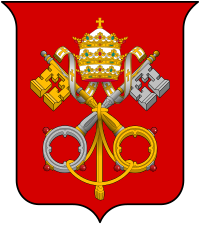Coat of arms of Pope Benedict XVI
| Coat of arms of Pope Benedict XVI | |
|---|---|
Benedict XVI | |
| Adopted | 2005 |
The
History
The coat of arms was published in April 2005, after the papal election, in the Osservatore Romano.[1]
Shield
The shape of the
Blazon
The blazon (the written description, in terminology peculiar to heraldry, of the contents of the coat of arms) given on the Vatican website is as follows:
This means, in non-technical English:
Note 1. A mantle outside the shield does not normally contain charges (an heraldic term for objects). Within the shield, as here, it is a religious symbol, and indicates ideals inspired in monastic spirituality.[
Charges

The charges of the arms — the
Scallop shell
The symbolism of the
The scallop shell is also an allusion to the Sacrament of Holy Baptism. In the Roman Catholic Church, a sea shell is often used to pour water over the head of the child being baptized. Thus, a sea shell is used to evoke the imagery of this rite which is fundamental to the Christian life.
The shell also stands for
Finally, the
Moor of Freising

The
The Moor's head is fairly common in European heraldry. It still appears today in the arms of Sardinia and Corsica, as well as in the blazons of various noble families. Italian heraldry, however, usually depicts the Moor wearing a white band around his head instead of a crown, indicating a slave who has been freed; whereas in German heraldry the Moor is shown wearing a crown. The Moor's head is common in the Bavarian tradition and is known as the caput Ethiopicum or the Moor of Freising.[2]
Corbinian's bear
A legend states that while traveling to Rome, Saint Corbinian's pack horse was killed by a bear. He commanded the bear to carry the load. Once he arrived, he released it from his service, and it returned to Bavaria. The implication is that "Christianity tamed and domesticated the ferocity of paganism and thus laid the foundations for a great civilization in the Duchy of Bavaria."[3] At the same time, Corbinian's bear, as God's beast of burden, symbolizes the weight of office that Benedict carried.
External ornaments


Traditionally, a pope's coat of arms was externally adorned only by the three-tiered
Mitre
In Pope Benedict's arms, the tiara is replaced with a silver mitre with three gold stripes.[4] These stripes recall the three crowns of the tiara, which came to represent the three powers of the Bishop of Rome: Orders, Jurisdiction and Magisterium. The stripes preserve that meaning and are joined at the centre to show their unity in the same person.
Pallium
The pallium with red crosses is also a new addition.[4] It represents a bishop's role of being pastor of the flock entrusted to him by Christ. The form of the pallium included in the coat of arms recalls that used by metropolitan archbishops (but with black crosses) rather than the much larger pallium worn by Pope Benedict at his inauguration.
After papal abdication
Following his resignation as pope in 2013, Benedict XVI became the first pope to step down from office since the resignation of
Cordero presented two hypothetical designs of how he believed the new coat of arms of the pope emeritus should look, replacing the bishop's mitre with a white

References
- ^ "L'Osservatore Romano publishes new Papal coat of arms". Catholic News Agency. 27 April 2005. Retrieved 2023-03-01.
- ^ "Coat of Arms of His Holiness Benedict XVI". Vatican Publishing House. Archived from the original on 26 February 2020. Retrieved 12 September 2020.
- ^ "The bear and the scallop-shell — a unique papal coat of arms". Catholic World News. 27 April 2005. Retrieved 5 January 2007.
- ^ a b Glatz, Carol (2005-05-18). "Pope drops papal crown from coat of arms, adds miter, pallium". Catholic News Service. Archived from the original on April 28, 2005. Retrieved 2012-03-23.
- ^ a b Glatz, Carol (2014-02-05). "Hark, the heraldry: cracking the coat-of-arms code". Catholic News Service. Retrieved 2024-01-09.
- ^ Estefania Aguirre (May 4, 2013). "Benedict XVI needs new coat of arms, designer says". Catholic News Agency.
External links
- "The Coat of Arms of His Holiness Benedict XVI". Libreria Editrice Vaticana.


